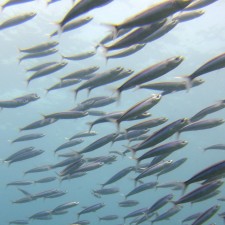Fish Stocks
Enumerating Fish Populations and Their Behavioral Dynamics
Fish species are extremely important to the well-being of ocean ecosystems and humanity. They provide roughly 40 percent of the protein consumed by nearly two-thirds of the world’s population and are the primary food source for many marine mammals.
Substantial evidence exists that fish populations are rapidly declining worldwide. Yet, with conventional sea-going survey methods, it is difficult to enumerate fish populations accurately or to study the behavioral dynamics of very large social groups or shoals of fish. As a result, the behavioral dynamics of large fish shoals remain largely unknown.
Understanding such behavioral dynamics is vital, however, because they govern fundamental processes such as spawning, migration, and variations in the ocean environment, predators, and prey. Similar challenges exist for studying the behavior of plankton and marine mammal distributions and their responses to environmental change.
Use of Acoustics and Acoustic Tagging
Researchers at MIT and WHOI are developing techniques such as acoustics and local ultrasonics that will help them measure the population distributions and behavior of fish, whales, and plankton. Such tools can also measure how sea life responds to the physical and chemical processes of the ocean and to human activities and the industrialization of the oceans. In addition, acoustic tagging of marine life is being used to study the behavior of endangered and keystone species of the ocean ecosystem.
Key Questions We’re Exploring
- What group behavioral mechanisms govern the evolution of fish and plankton shoals? How can they be determined by ocean observations, and how can we model them?
- What are the effects of climate change on oceanic fish, plankton, and marine mammal populations?
- Are there viable methods for restoring decimated marine populations and ecosystems?







